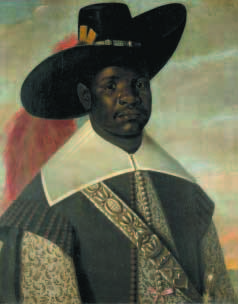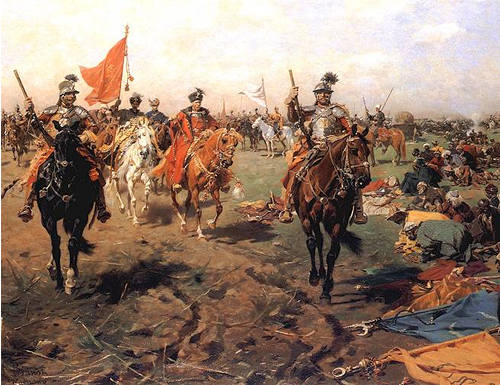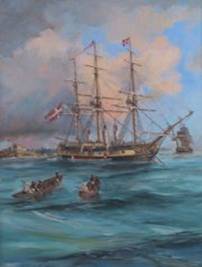Most of us seem to think that the presence of Africans in Europe is of recent times, though history shows otherwise. Africa had flourishing societies and highly developed cultures long before Europe, and of course people of Africa did travel and explore other continents. Black legions invaded Germany with Julius Ceasar, there have been discoveries in France, Spain, Italy, Denmark, Ireland, England and Finland, Scandinavia and as far north as the Arctic Circle. There were blacks among the Celts and Vikings, I have read some place that Thorhall the Hunter, Thorstein the Black and Halvdan Svarte (the first king to unite Norway) were of African origin (though I have not been able to have this confirmed by my Norwegian history book, it just says he was called Halvdan the Black, because of his black hair).
A part of history that is unknown to most Norwegians, probably because we are ashamed of it, is the Danish-Norwegian participation in the slave trade from Africa. Between 1660 and 1814, Norway was in union with Denmark and under Danish legislation. Between the years 1778 until 1789, Denmark-Norway was responsible for bringing 17,113 Africans to the Caribbean.
Through the the West-Indian – Guinean Company, Denmark-Norway participated in the triangular trade between Europe, Africa (where it had a trade fortess)and the Caribbean where it had colonies and sugar, tobacco and mahogany plantations on Saint Croix, Saint Thomas and Saint John.
In 1752 – 1753, the West-Indian – Guinean Company based in Copenhagen built the frigate Fredensborg and equipped it as a slave ship to be used in the triangular trade with limited success. It was then sailing in the Caribbean, until it sank outside of Tromøya, Arendal off the coast of Norway
in 1768. Shortly after the loss of the ship, the company had an identical ship built, which also was used in the triangular trade between Europe, Africa and the Caribbean.

Even before the West-Indian – Guinean company built the ship Fredensborg and started trading slaves, slaves were brought in thousands to Europe. It was a sign of status for a family to have a young African girl or boy as a servant. There are family portraits that show the family and a black girl or boy in the background. It was a sign of exclusiveness, because it was something very few could afford.
The story about Christian Hansen Ernst.
In spite his very Danish name, Christian Hansen Ernst was of African descent, brought to Denmark as a little boy, as a gift to Ulrik Christian Gyldenløve 1699 (son of the Danish king Fredrik III, born out of wedlock, thus the name Gyldenløve, it was given to all the sons of Danish kings born out of wedlock). First Christian was a servant at Charlottenberg Castle, before Gyldenløve became the Governor in Norway from 1664 to Gyldenløve was especially fond of Christian Hansen Ernst, and appointed him postmaster in Kragerø, Norway in 1694 and he became the first “black” senior civil servant in Norway. Ernst was stabbed to death in an alley in 1695, allegedly because he was too fond of women…….

In the late 1800's, the African population on St.Croix was 20, 000 people. The large demand for servants in Europe, lead to slaves being brought in hundreds to Norway-Denmark.
A merchant from Bergen, Christopher Harmens (1774 – 1829), travelled as a young man to St.Croix. Under the Caribbean sun his blood started boiling and he fell in love with a very beautiful young woman of African descent. Her feelings were mutual and he decided to bring her home to Bergen as his fiancé. When Christopher presented his bride to his father, a merchant and the richest man in Bergen, he gave them a very cool welcome and did not approve of the liaison. No matter how much they pleaded and shed tears, Harmens Sr. was unmovable. Christopher had to take his fiancé over the ocean back to St.Croix again and returned alone back to Bergen. The colour of his hair had turned white during the trip. This unhappy love story was well known in Bergen, and the locals called him “Kvitebjørn” (White Bear) because of his white hair, and he was seen as a lonely original who never smiled and who's mind was dark and sad. He never remarried.
A young boy called Adam was sold at the age of 13 as slave on St.Croix to Hans Herlofson of Arendal, a ship owner and merchant. It is not likely he bought Adam to get cheap labour, according to himself he paid the corresponding amount of what 60 cows would have cost. He would have been able to hire much cheaper help locally in Arendal. Most likely Herlofson wanted to bring home something exotic, which was common among rich merchant families in Denmark-Norway. This emphasized the exclusiveness of these families, because not very many could afford it.

Adam was not very happy, his health was poor in the cold climate and he dreaded Herlofsons temper. One night in 1791 he ran away because he feared Herlofson would finally make his threats serious and beat him dead. He hid in the forest for some time, until he went to see the magistrate. He was too scared to return to Herlofsens house. Herlofson was asked if he wanted to take him back, but he responded that although he had paid a lot of money for him, he would not take him back, and asked that he be put in a correctional facility. Adam on the other hand had asked the magistrate for a passport, so that he could return to St.Croix, and he could furthermore inform that his mother, who had been emancipated before Adam was sold, had offered to buy him free. Herlofsen now said, that he wanted Adam back, after he had served some time in jail for the crime he had committed.
The magistrate doubted very much that the manner in which Adam had been bought did not make him a free man in Norway. He could neither see that Adam had committed any crime, unless Herlofsen could prove it. Adam was now a free man. The magistrate had also enforced his power among the rich merchants, demonstrating that they did not own other people.
It is not clear what happened to Adam after this, whether he returned to St.Croix or if he died.
Adam may have made Herlofsen feel exclusive, but to others the sight of Adam was the living proof of Denmark-Norways' slave- and colonial politics. When these politics came to display in a free society, and local laws had to be applied, they had no choice but to set Adam free.





 We’ll protect state wealth from opaque deals – Prof Jane Naana
We’ll protect state wealth from opaque deals – Prof Jane Naana
 Mauritania president says running for second term in June polls
Mauritania president says running for second term in June polls
 I won't ever say I was a mere driver’s mate' — Prof. Opoku-Agyemang
I won't ever say I was a mere driver’s mate' — Prof. Opoku-Agyemang
 2024 polls: 'EC struggling to defend credibility'— Prof. Opoku-Agyemang
2024 polls: 'EC struggling to defend credibility'— Prof. Opoku-Agyemang
 Akufo-Addo gov't's 'greed, unbridled arrogance, unrestrained impunity, sheer dis...
Akufo-Addo gov't's 'greed, unbridled arrogance, unrestrained impunity, sheer dis...
 Election 2024: Ghana needs an urgent reset, a leadership that is inspiring – Ma...
Election 2024: Ghana needs an urgent reset, a leadership that is inspiring – Ma...
 Partner NDC to rollout a future of limitless prospects – Prof Jane Naana Opoku-A...
Partner NDC to rollout a future of limitless prospects – Prof Jane Naana Opoku-A...
 NPP will remain in gov’t till Jesus comes — Diana Asamoah
NPP will remain in gov’t till Jesus comes — Diana Asamoah
 Sunyani Technical University demands apology from former SRC president over sex-...
Sunyani Technical University demands apology from former SRC president over sex-...
 'Dumsor' was resolved by Mahama but ‘incompetent' Akufo-Addo has destroyed the g...
'Dumsor' was resolved by Mahama but ‘incompetent' Akufo-Addo has destroyed the g...
